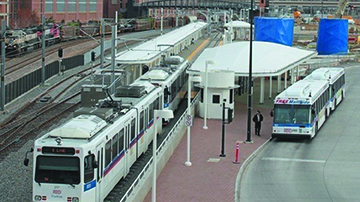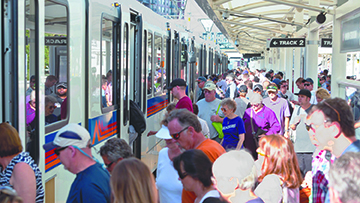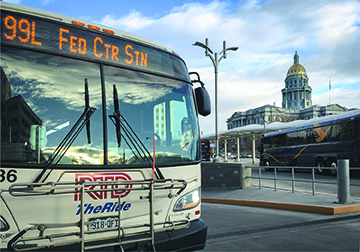Drowning In Debt, RTD Now Needs Three Times
The Equipment, Operators For Pre-Pandemic Passenger Load
by Glen Richardson
It has been a ridership roller coaster for RTD buses and trains since the pandemic hit in March, and the roads and tracks ahead look bleak. The ritual of standing shoulder-to-shoulder with strangers during rush hour is history, eradicated by the coronavirus.

While the agency grapples with a path forward, it also faces plummeting ridership and tax revenue. Even if RTD’s financial projections — originally forecast as a $1.1 billion revenue loss through 2026 — drops to just 9% vs. the originally predicted 24% — the road ahead remains treacherous and volatile.
Social distancing rules will not only impede but essentially preclude a rebound. Why? To operate what was a pre-pandemic commuter load back in January, now requires three times the equipment and operators because of the cap on number of passengers. Bottom Line: The agency will likely not be able to restore service to its pre-pandemic levels — or anything close to it.
Huge Debt Burden
RTD was in a delicate financial spot even before the coronavirus. By adding five new train lines since 2012 — a fifth is expected to open in Sept. — the agency is drowning in debt. RTD is due to pay $252 million in debt and interest this year alone. That’s why the agency had made a $40 million cut in its 2020 budget. Even if RTD loses significantly less than the quarter-billion dollars originally projected for 2020, the budget is still a full blown problem.
RTD’s FasTrack program has never met the yearly forecasts following voter approval of the package in 2004. The recession that followed made the difference between forecasted and actual revenue even larger. Thus, RTD took out loans to build many of the train lines it promised voters in 2004.
That’s why now it’s saddled with massive debt payments. RTD now estimates that more than 90% of the $194 million in FasTracks sales tax revenue it expects to collect in 2021 will go to debt service.
Cost Cutting

“We have an incredible system right now but it came as an expense,” admits Heather McKillop, RTD’s financial officer. “It comes as a long-term expense that has to be paid off.”
In addition to the lower-than-expected sales tax revenue, staff must also deal with higher-than-expected operations and maintenance costs for its new train lines plus an aging system that needs repair.
The agency is now cutting cost by delaying projects and freezing administrative hiring. RTD is also reportedly considering furlough days for all workers. Collective bargaining agreements with drivers, however, don’t allow for furloughs and likely won’t apply to them. Given the recent hiring and retention problems with drivers, that is probably a good thing.
Altering Schedules
Among the possible solutions is altering schedules to avoid crowded trains while increasing frequency throughout the day rather than being concentrated at rush hour. That assumes, of course employers are willing to stagger work hours to ease crowding in public transportation. Even so, the agency must demonstrate that the system is clean, safe and that social distancing is mandated.

As with so many other businesses, the scary part for RTD is the potential duration of the crisis — it isn’t going away anytime soon.
RTD resumed fare collection and front-door boarding on all buses July 1 and passengers are required to wear face covering. Nevertheless they’re only buying time with the virus, they’re not removing it from the equation. The agency must also face the fact many previous riders may continue to work remotely — even if only some of the time — when the coronavirus ends.
Reimagining RTD
“The world has changed, we recognize that and we are reimagining RTD to support this new normal and these new challenges,” says Bill Van Meter, assistant general manager of planning.
Much of RTD’s budget gap for 2020 will be funded by a large grant from the Coronavirus Aid, Relief & Economic Security Act (CARES). RTD leadership admits, however, that they cannot count on a second round of funding.
The agency is continuing to reduce costs and streamline to close the large financial gap. Cuts made to the 2020 budget under the worst-case scenario may result in a surplus by the end of the year, which would be carried forward to the 2021 budget. That would help offset projected losses of sales and use tax revenue, decreased fare collection and the unlikely allocation of additional CARES Act funding.
Riding Healthy

Denver and state health officials say social distancing — at least six feet from other passengers — must be maintained. RTD claims it is adding additional vehicles on busy routes to help maintain the required space between passengers.
RTD is also requiring face covering among both passengers and operators. Staying quiet, as conversation — especially yelling or singing — amplify the spread of the virus. “A quiet car is a safer car,” they say.
Finally, health officials urge passengers to use hand sanitizers or wipes after riding buses and trains.
